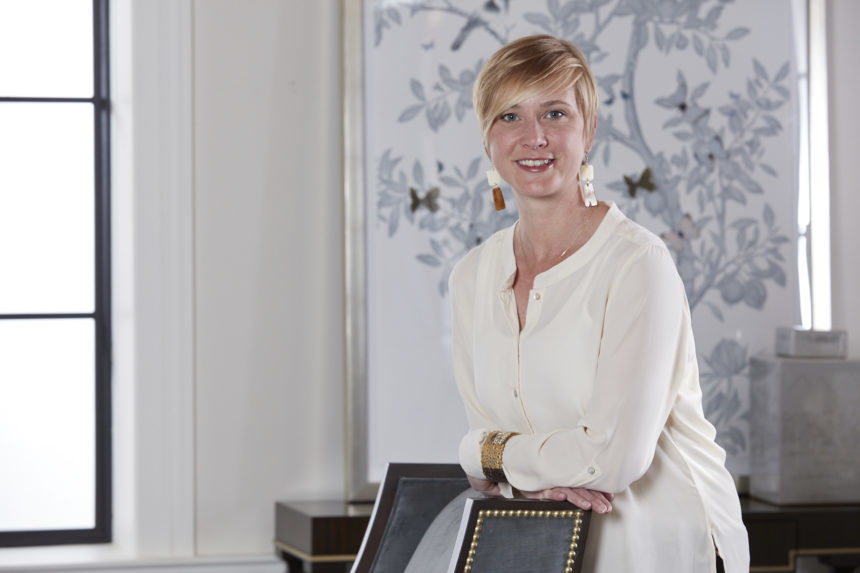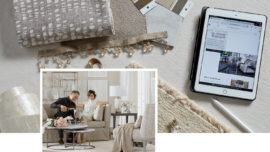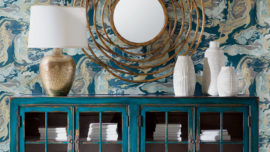In which we discuss unicorns, the secret society of blacksmithing, and the only definition of transitional you’ll ever need.
“Sometimes you can make a unicorn.”
This improbable statement comes from Laura Chapman, Ethan Allen’s normally quite rational senior director of product design, who sat down recently to talk about what she does and how and why she does it.
We weren’t expecting mythological creatures to play a part, but like any good designer, Laura isn’t one to let convention stand in the way of possibility. Also, it turns out, she had a solid, not-at-all loopy reason for saying it.
“I’m looking for unicorns all the time,” she explains. “That’s where design comes from, if you’re doing it right and doing a good job. You look at tear sheets [an interior design term for product information and specs] and do trend research and go to the shows [trade shows, where inspirational designs debut; kind of like Fashion Week for furniture], and you still have this thing in your head that you haven’t seen. That’s the unicorn.”
Laura started at Ethan Allen about four years ago, though she counts the time a little differently. “Nine introductions,” she laughs – nine distinct product launches of dozens of products each, to which she contributed. That’s more than two introductions a year, each requiring knowledge, inspiration, a fresh perspective, a willingness to jump into the unknown.
“For any designer, it’s hard not to repeat what you just did, maybe with a slight variation,” she says. “You have to go past what you know works, to take a bigger risk into something that’s unknown.”
Art in the Family
Furniture wasn’t always part of Laura’s plan.
She earned a degree in painting from the University of Cincinnati which, she says, “qualified me to be a starving artist.” She worked in bookstores; her boyfriend (now husband) was, and is still, an artist blacksmith. It was a paycheck-to-paycheck life, but also a flexible one.
Stop. An artist blacksmith?
“Not to be mistaken for a farrier,” she clarifies, “who might make shoes for unicorns.”
Laura’s husband, Andy, makes tools, furniture, and art, and he teaches at a local arts center and through the community youth agency, where children as young as ten can become amateur smiths, if they’re interested. “It’s always been like this underground subculture,” Laura explains. “These smiths know each other or find each other. Because of shows on the History Channel, it’s even more popular now, but also more like a cult following. People want to become weekend blacksmiths, so his classes are booked.”
Even their kids are in on the action. “Lucy will be five this month. She has a half-pound hammer and an anvil about the size of that computer mouse. Ben is eight, so his hammer weighs four pounds, and his anvil’s a little bigger. We give them things to mash – bottle caps and copper wire. They’re both very interested!” Ben even knows how to use the vise, which he’s not supposed to do when mom’s not looking. “Of course, if I turn my back, something’s in that vise. It might be something that’s meant to be there, but it might be a Tonka truck.”
(We’d like to clarify here: Laura’s children are not in a forge! Theirs is a fire-free experience. So far.)
Time for a Change
Because they could, Laura and her husband packed everything into their car, took a month-long trip around the country, and landed in Austin, Texas. In the four years they lived in Texas, Laura volunteered in art galleries and found gigs at Whole Foods: first, managing the bakery, and then, as the beer buyer. “When you manage a department at Whole Foods, it’s like running your own business. I earned a really thick skin dealing with beer vendors every day. Some were great, but some thought they could take advantage, and I was not that person.”
OK, but how did she get from beer to product design? In Laura’s family, a lot of life-changing decisions are made over big, greasy spoon breakfasts in cafés. “It’s how we decided to move to Texas, and it’s how we decided, ‘Hey, someone has to make a living, I have these weird noodly drawings of furniture in my notebook, so why don’t I do that?”
Next stop: a tiny design school in western Michigan (once a hub of U.S. furniture manufacturing). She specialized in upholstery design because she liked the sculptural nature of the products, and she learned about manufacturing and research and development.
The first company she worked for after graduation sold furniture by the pound, as in, Buy two recliners, get the table that fits between them free! “That table was one of my first pieces,” she shares, “and that tough skin I got as a beer buyer really came in handy. These guys were the definition of old school.” From there, she networked her way to Mitchell Gold, where she eventually became the head of both upholstery design and R&D.
Form Follows Function
Rather than dreaming up something pretty, then figuring out how to make it, Laura says the process of good product design is the opposite. “You can build anything once; it’s a different ballgame to build something that will hold up to repeated use – or repeated production.”
Laura got her education in construction while designing upholstery for a firm where everything is manufactured on site. “Knowing the construction requirements and how to build for comfort – those are the pillars for everything else. I learned a lot about construction because I saw it happen and had it explained it to me. I can’t engineer a frame myself, but I can speak intelligently on how to problem solve thanks to that. I can then make the form around it whatever I want it to be. ”
Laura approaches each new design as an assignment. “An assignment might develop because we have a need in the line, or it might be that we’ve identified an emerging trend. Every once in a while, there’s a design we’ll fight for because no one else is doing it and we know should try it.” Of course, sometimes those designs turn out to be popular, which, Laura maintains, is proof that “people see the unicorns!”
She stays on top of style trends and knows what other manufacturers are doing, but for real inspiration, she has a favorite source: vintage. “I love getting abstract ideas from vintage furniture – collaging this leg with that seat with this arm. And because I’m the one sketching it up, I don’t have to explain to anybody what Frankensteining those pieces together should look like.”
Transitional might be the most common description of style in the last 20 years, even if few people can tell you exactly what it is. Laura can! In Laura’s mind, transitional style is about taking a vintage form and boiling it down to its essentials. “Picture a Queen Anne highboy: It has the big crown on top, the cabriole leg, carvings, details. To make it transitional, you’d take it down to just the shape. Maybe it still has the crown, but there’s no carving; it has the cabriole leg, but it isn’t ball-and-claw.” Taking timeless styles down to their essentials preserves the form, but delivers something more modern because the traditional elements have been eliminated. Transitional can also go the other way, relaxing a sleek modern form by giving it a new finish, for example, to make it more casual.
One of the most rewarding parts of Laura’s job is encouraging her team to chase those elusive unicorns. “When you’re pushing the whole team to do something new – the designers, the engineers, the manufacturing team – and then it happens, it’s exciting. You achieve so many different goals on the way to getting a really unique design. If we’re working on a new product and referencing something that’s truly vintage or antique – I have no problem with that. But this ephemeral it-doesn’t-exist-but-can-we-get-there? sort of thing; that’s when you know you’re really onto something.”
Laura never let go of her dream of being an artist of the non-starving variety; she just found an unexpected way to make it happen. “People love their furniture,” she says. “They love their homes. I think the idea of making functional art, art that performs a service, is ultimately how I ended up here.”




